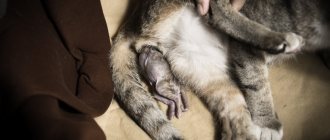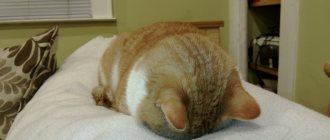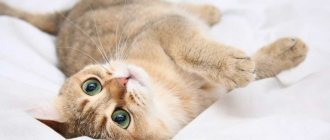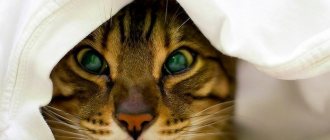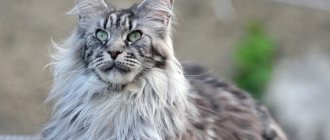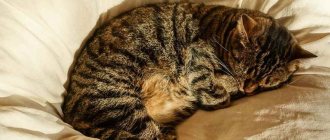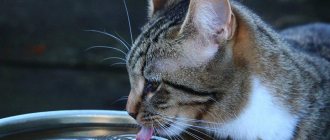Cat's age for first pregnancy
If the animal lives in the house, then the possible pregnancy of the cat is under the control of its owner, who must know that the pet cannot yet give birth until it is one and a half years old. This can negatively affect the young and immature body of a giving birth cat and her babies. Since animals are most susceptible to various diseases during pregnancy, giving birth to cats when they are too young can be especially dangerous.
Of course, in fact, animals can interbreed starting from 6 months, but you should take care of your pet and prevent such cases. The best age for the first birth: 2–3 years.
You also need to pay attention to the breed and health of your pet. After all, a cat’s body is as individual as a woman’s body, and each requires its own special approach.
If the owner wants to have healthy kittens from his pet in the future, but not too early, using hormonal drugs to interrupt estrus is highly not recommended: even long after abandoning them, the cat can only have miscarriages and kittens that are unlikely to live long.
How often do cats give birth?
Pets often give birth if their owners do not control their sex life. An animal can give birth to kittens 2-4 times a year. Sometimes this figure can reach up to 5. Frequent childbirth and lack of normal rest between pregnancies have a bad effect on the female’s body. Cats that often bear offspring lose resistance to various infections because the body does not have time to recover after giving birth. The female can earn:
- rachiocampsis;
- respiratory system disease;
- damage to the nervous system;
- disease of the reproductive organs;
- hepatitis and necrosis.
For your information! Constant pregnancies contribute to rapid aging and shorten the life of the female.
Onset of heat
Every owner should know that the animal's first heat signals that the cat is ready to reproduce. It occurs when the female becomes sexually mature, usually from 7 to 10 months after birth, although physiologically the animal matures only at 12–14 months.
Estrus occurs in pets several times a year, usually about three, mainly in the first half of the year. Overly loving cats are ready for fertilization all year round, most often this applies to oriental breeds. Estrus lasts about two weeks. An exception is the time when mothers feed their kittens milk.
The period of onset of estrus depends on:
- Favorite breeds.
- Seasons.
- Having a cat nearby.
- Animal body size.
You can determine that an animal is in heat by the following factors:
- The cat is in an excited state.
- If you pet the animal, it will begin to get excited and raise its tail.
- The pet screams loudly and hysterically.
- The female behaves restlessly.
You can also observe this moment physiologically - the genitals become larger, discharge appears, trips to the toilet become more frequent. As a result, cats begin to lick themselves more. Animals also begin to be more affectionate and purr more. But some individuals can be aggressive.
Periods of heat
Sexual hunting is divided into 4 periods.
- Proestrus is the initial phase, lasting 1–4 days. The cat becomes a little more affectionate. Appetite improves. The animal meows quietly, sometimes the sounds are barely audible. The genitals become larger and produce clear mucus. At this moment, the cat does not allow males to approach.
- Estrus lasts 1–1.5 weeks and is the second stage. In this phase, estrus is especially pronounced. The animal behaves very gently, constantly wriggles and meows protractedly. If you run your hand along the female's back, her body will sag. The best time for mating is 3–5 days of estrus.
- Metestrus - the phase when the sexual instinct slowly declines, lasts 3-12 days. If fertilization occurred at the second stage, then at this point the pet begins to hiss at the males. But sometimes a cat’s pregnancy is false, and when the owners are already sure that fertilization has occurred, it turns out that this is not so. Usually false symptoms disappear within a month and a half after estrus.
- Anestrus occurs if fertilization has not occurred. The female gradually becomes calmer. The heat is completely over.
If the cat is pregnant, then in 60–70 days you can expect the birth of kittens.
How to calm down during heat
During the period of heat, the cat becomes very agitated and causes discomfort to the people around her. Constant loud cat screams, attempts to run out of the house, aggression cannot please the owners, so it is so important to treat the pet’s condition with understanding and try to help the cat survive this stage as painlessly as possible. Today, veterinarians suggest using the following methods:
- Meeting with a cat. The effectiveness here is one hundred percent, however, after such a meeting of the pets, the owners will have another question: “what to do with the offspring in the future?” It’s great if the mating was with purebred cats, and the kittens, after birth, will expect good hands.
- Sterilizing a cat involves removing the ovaries and surgically ligating the fallopian tubes. More detailed information on this method can be obtained from any veterinary clinic.
- Using a drug that regulates the sexual desire of pets.
- Cat hunting can be calmed down with the help of a hormonal drug, such as countersex, pilkan. However, such funds can be used no more than 1-2 times a year.
Frequent use of hormonal drugs can lead to hormonal imbalance, leading to uterine and ovarian cancer.
Sedatives used in human use can also alleviate the condition of a pet during estrus:
- ¼ tablet of suprastin for every 3 kg of animal body weight, taken twice a day for three days
- 5 drops of valerian at night; 15 drops of fospasim twice a day; 5 drops of motherwort morning and evening.
Signs of pregnancy
A cat's pregnancy lasts about 9 weeks. Kittens born 7 days earlier do not always survive. Therefore, it is necessary to treat the “future mother” as carefully as possible so that the cat’s pregnancy passes without complications.
In the first 3 weeks, the female becomes calmer, and her actions are measured. Appetite decreases and the cat may begin to vomit. The nipples acquire a pink color, the shade is especially saturated during the animal’s first pregnancy, then it may even have a reddish appearance. At week 5, the embryos become larger and can even be felt through the furry pet’s tummy, which can already move. But in no case should you put too much pressure on the cat’s abdominal cavity - your careless actions can harm the kitten’s health or even provoke a miscarriage. It is still impossible to tactilely feel how many kittens are in the womb.
After the 5th week, the pet’s belly increases sharply, and the embryos in the animal’s body also grow and develop quickly, but the opportunity to feel their heads separately appears only after the 7th week. From that moment on, the caring “future mother” is restlessly looking for a nest for her babies. The cat begins to eat a lot.
By week 9, the mammary glands become larger and large nipples stand out. The female becomes a little withdrawn. A thick fluid may appear near the vulva. Soon the cats give birth.
Does gestational age depend on the number of kittens?
If you thought that kittens grow like zucchini in a garden, slowly and unhurriedly, then you are very mistaken. The fact is that experts distinguish five periods in cat pregnancy, each of which is extremely important for the proper formation of fetuses.
Let's list each of them:
- The first stage lasts exactly 25 days from the moment of mating. At this time, kittens begin to form, and numerous hormonal changes occur in the body of the expectant mother. From the outside, they are also quite noticeable: they swell, enlarge the nipples, and their color changes to deep pink. The cat becomes calm, sometimes more playful, and tends to spend more time next to the person.
- The second stage begins at 30-31 days. During this period, intensive growth and formation of embryos continues, they quickly increase in size. The animal prefers to devote more time to sleep and rest, and its appetite increases significantly.
- The fact of cat pregnancy itself becomes most noticeable in the fifth or sixth week, when the practically formed kittens completely “hang out” the uterus and it descends into the abdominal cavity. The cat's belly sags, it becomes very calm and phlegmatic. The kittens themselves are almost completely “ready” at this time.
- The fourth stage is perhaps the most difficult for the animal. At this time, kittens’ fur begins to grow rapidly, and all internal systems of the body, including excretory systems, are fully activated. Due to an increase in the level of their metabolic products, the cat may experience a significant decrease in appetite. This period lasts from approximately 40 to 50 days.
- Fifth stage. If you put your hand on the animal’s belly at this time, you can clearly feel how the kittens move. The cat is restless, looking for the best place to give birth.
READ Which toilet for a rabbit to choose
Or vice versa? Does the number of kittens depend on their gestation period? Yes, there is some dependence. The more babies there are, the shorter the period may be, especially for young cats. True, the greater the number of kittens in the belly of a young mother, the higher the likelihood of some kind of trouble. This is due to the fact that her fragile body may not be able to cope with such a high load.
Caring for a cat during pregnancy
A first-time cat, more than ever, needs care and increased attentiveness from the owner. After all, a cat’s pregnancy and first birth are probably the most important and exciting period in her life.
The owner needs to make sure that the pet does not try to jump on high structures; in the “position” her center of gravity shifts, which is why both she and the babies can suffer during such jumps.
The animal's nutrition must be complete - only natural and fresh products, if food, then only super premium class. In the first weeks of pregnancy, food should include calcium, protein, healthy vitamins and minerals and taurine. It is worth giving cottage cheese to a primiparous cat more often. After 4 weeks, food containing protein is especially beneficial. From 7 weeks, you need to increase the number of feedings, because babies also want to eat well; the daily norm should be 4-5 times a day. But overfeeding the animal is strictly not recommended - if the cat becomes fat, the first birth can be extremely difficult. Therefore, portions need to be reduced. Raw meat and fish should be excluded from the diet.
It is also necessary to organize a cozy nest for the first-time cat and her babies. Although it is worth considering that the owner’s opinion may not coincide with the cat’s worldview. Since animals at this moment prefer to hide so that no one can see them. But it’s still worth making a warm and comfortable place for the kittens; a box is best for this. A soft diaper or blanket would be a good bedding. It is especially convenient for the first-time cat and the owner when the “nest” has a “roof”. In order for your pet to like the house, you need to gradually accustom her to it.
Cat pregnancy by week
Already from approximately 6-8 months of age, most cats successfully become pregnant and give birth to healthy offspring. The owner’s task is to catch the right moment for mating or to prevent it.
The age at which a cat can become pregnant depends on both the breed and the individual. But the development of embryos by days and weeks occurs almost the same in all cats, and after 60-68 days from the date of mating, the pet will be ready to give birth.
Is this a false pregnancy?
When the mating is planned, and the kittens are long-awaited, of course, you want to know for sure whether everything worked out. A cat can become pregnant only if the mating coincides with the period of readiness for ovulation and implantation of embryos. At different stages of cat pregnancy, doctors use different diagnostic methods.
Hormonal method
Cats are special in that they ovulate only after multiple matings during a short period of heat. In this case, the onset of pregnancy is determined using endocrine tests and blood tests:
- Immediately after mating, luteinizing hormone is released into the blood, stimulating ovulation and maturation of the corpus luteum. Its presence in the blood helps determine that ovulation has occurred;
- Progesterone, produced by the ovaries, begins to increase after ovulation and continues to increase until the 30th day of pregnancy. And then its level slowly decreases and drops very sharply just before childbirth. If progesterone levels rapidly decrease 1-2 weeks after mating, it means that the pregnancy was false and the cat may become pregnant in the next cycle. The test is valid from 40-45 days;
- Relaxin is another specific pregnancy hormone. In cats, it increases in serum from the 25th day of gestation. This method would be very reliable if all clinics performed such an analysis.
Lack of heat and physical changes
The absence of estrus, or simply “delay” for 45 days, almost always indicates pregnancy. The cat does not “walk” and does not exhibit behavior characteristic of estrus. Although a cat’s first pregnancy can begin completely unnoticed even for her.
With palpation, you can achieve 90% accuracy and even determine the number of kittens. Already on days 26-30, embryos can be felt as “balls”. From the 35th day they stretch and enlarge. An experienced surgeon will be able to determine the fact of pregnancy starting from day 28.
Something else interesting: Artificial feeding of kittens
Changes in behavior are also a sign that will appear in the second half of the term: the cat becomes more careful, slower, eats more, and noticeably gains weight. Food preferences may change and signs of toxicosis may appear.
Instrumental methods
With the help of various devices, diagnosis is simplified, although not all methods are equally effective. For example, there is no point in trying to hear the fetal heartbeat in the early stages. But in the later stages, you can auscultate the kittens’ hearts through a stethoscope. Their heart rate is twice that of their mother.
An X-ray from mid-pregnancy will show an enlarged uterus and displacement of the small intestine. But in the early stages of pregnancy, only soft tissue can be seen, which means pregnancy can be confused with diseases of the reproductive system. From day 40, the photo will already show the kittens’ ridges. From about the same time, ionizing radiation does not harm fruits.
B-mode ultrasound confirms the presence of fertilized eggs in the early stages and is considered the safest method for the fetus and mother. The study is relevant from the 4-5th week after mating.
How kittens develop in utero
The development of fetuses and their maturity in the prenatal period is usually assessed in weeks, and in the earliest stages - in days. And many important processes occur in the first hours after mating:
- Mating stimulates ovulation in a cat. The brain produces luteinizing hormone, which triggers the release of eggs from the ovary. This process will take 36-48 hours and only one in a hundred sperm will reach the target;
- In the uterus, over the next 24 hours, sperm must meet eggs - this is fertilization. The genetic material of the mother and father are combined to form an embryo. Further, the cat’s pregnancy develops in strict accordance with the “schedule” conceived by nature.
First week (0-7 days)
The embryo grows and its cells divide. Blastocysts, freely moving throughout the uterus, attach to the uterine stacks approximately 7-10 days after mating. This process is called implantation and this is where the countdown begins.
Second-third week (8-21 days)
The placenta is formed. By day 15, it will fully provide protection and nutrition to the embryo. The embryo is still very small, but in its C-shape one can already discern the future head and tail. The fertilized egg can be palpated in the uterus. The cat becomes more capricious in its diet and spends a lot of time alone.
Something else interesting: How to help a cat give birth when there is no doctor nearby
Fourth week (22-28 days)
The fertilized egg has a size of 15-20 mm. At this stage, it is quite difficult to distinguish a cat embryo from other mammals. But the formation of internal organs has already begun. First of all, the rudiments of the brain and heart develop.
On a sensitive ultrasound you can already hear this heart - 230 beats per minute! On day 28, the cat's paws begin to form: fur, pads and claws. The mother cat may feel nauseous. Outwardly, the pregnancy is not yet noticeable, but on an ultrasound you can already see something.
Fifth-sixth week (29-42 days)
Sense organs are formed. Nature pays special attention to the cat's hearing and sense of balance, and the skin prepares for the development of whiskers (whiskers). The first, still soft, bones appear.
After day 38, the muscles and nervous system actively develop. The kitten begins to actively move inside the uterus. Some scientists suggest that already at this stage the psyche and character begin to form, and it is very important that the mother is in a good mood.
Seventh-eighth week (43-56 days)
Bones, especially the spine, become visible on x-rays due to skeletal calcification. The fur is almost formed.
The embryo already resembles a kitten in all its outlines, but still has very short limbs and a tail. They will stretch out a little before birth.
At day 50, the kittens are generally ready for birth, but are still very vulnerable and will gain strength over the next 10-14 days. During this time, they will “work out” the reflexes of breathing, hiccups, sucking and everything that the baby will need in his future life.
Ninth week: preparing for childbirth
The mother begins preparations for the birth of her offspring. Her body signals the approach of labor with the first “test” contractions and the appearance of colostrum.
The cat looks for a place for a nest and settles in it. It is important at this time not to create stress for the expectant mother and to carefully monitor her diet and well-being.
This is a normal cat pregnancy week by week. For the next two months, the mother will warm, educate and teach her babies all the cat wisdom.
Interestingly, 1-3 weeks before giving birth, cats are ready for a new relationship. They can go on a spree and get pregnant immediately after giving birth. Therefore, free-living cats give birth throughout their lives, many 4-5 times a year. And at what age a mother can give birth to her last kitten is a matter of health and living conditions.
Useful materials:
- Cutaneous horn General description of the disease Cutaneous horn on the forehead or face (ICD 10 code - L57.0) -...
- The cat has cancer Stages of mammary gland cancer in cats Like in humans, cat mammary cancer has ...
- Itching and odorless discharge Main causesBefore considering the factors that provoke the appearance of discharge that has a sour odor, it is necessary to immediately note...
- Normal temperature in animals Normal temperature in different types of animals Veterinary services Day hospital for animals Veterinary certificates Vaccination…
Do I need to be examined by a doctor?
A primiparous cat definitely needs to be seen by a doctor. Using an ultrasound, a veterinarian will not only distinguish a cat’s false pregnancy from a real one, but will also be able to calculate the number of kittens in the womb.
She will also assess the pet’s condition, take into account all diseases that may affect the course of pregnancy, and, if necessary, tell you what tests should be done. He will also advise what the owner should do when a cat goes into labor, and what emergency services can be contacted if it becomes complicated.
Reproductive process
Theoretically, a cat can give birth already at the age of six months, but at such a time mating occurs only among inhabitants of garbage dumps.
No normal breeder will breed a cat before the third heat, since kittens born to such young animals are highly likely to be defective. And the cat itself, having given birth to offspring at the age of only a few weeks, will never become a full-fledged, good producer. Her body will simply spend all its reserves and will no longer be able to recover. As a rule, that same physiological maturity occurs at approximately the age of five to nine months. We think every cat breeder is familiar with the “symptoms” of its manifestation: the animal becomes nervous, excitable, rushes around the house, screams loudly and heart-rendingly, arches its back and caresses, clearly showing its intentions.
Some animals sometimes manage to “roll” on their butts all over the carpets, which does not make the owners too happy. At this time, in no case should you “follow” the cat and let her go to the cats! Now there are many means that suppress sexual desire during the first heat period. Take advantage of them!
Only by the second or third heat does the cat become truly sexually mature and can give birth to normal, healthy kittens. In this case, you can already plan to breed the animal, since the time has come for physical maturity. Please note that the cat may not accept the cat the first time, so after a while the “March games” may begin again. And further.
Pregnancy for felines lasts an average of 9 weeks. In terms of this, this is 2.5-3 months. In days, the duration of gestation is 59-67 days.
Remember that an animal can give birth to healthy offspring ahead of schedule, or it can “transition”, but end up lambing with non-viable or underdeveloped kittens.
It all depends on the level of health of the animal, the presence of identified and hidden chronic diseases, complications with viruses and infections, due to which the body weakens and loses the ability to nourish babies in the womb.
Cats become ready to become pregnant immediately after their first heat. This is a natural process that the owner must pay close attention to, since it is the main regulator of the animal’s reproductive behavior. A cat's first heat usually occurs at 11–13 months. In case of hormonal imbalances, it can occur earlier at 5–9 months. Typically, physiological maturation is recorded at 6–8 months.
Signs of labor
To determine that a cat is giving birth, you need to know the characteristic signs that accompany the first birth:
- 1–3 days before the event, the temperature of the giving birth cat drops to 37°.
- Within 1–2 days, the animal very often licks the genitals; the mucous membranes of the giving birth cat take on a pink or even red tint.
- The mammary glands may become very engorged, causing the skin around the nipples to become hot to the touch.
- The animal seems depressed and apathetic.
- 4–8 hours before contractions, the pet takes on a hunched appearance due to training contractions. She can also call her owner for help or hide in a secluded place.
- The appetite of a giving birth cat is reduced to a minimum, and she drinks liquid in the same amount.
At first, even before contractions, the plug comes off in a giving birth cat, but it can be difficult to notice, since it can come off in parts or when the animal goes to the toilet. At this moment, the kittens begin to actively move in order to have time to turn correctly at the time of birth.
Caring for an animal in position
Pregnant pets require increased attention at all stages of their existence. They are kept away from danger, fed properly, their coat taken care of, and comfortable living conditions are created.
Animals in position are fed nourishingly and unobtrusively, with food balanced in terms of vitamin and mineral balance. You should not radically change your usual feeding routine - this can cause allergies and rejection in your pet. It is considered sufficient to add the necessary components, checking a professionally prepared diet. You can purchase specialized food for pregnant cats, but your pet should be switched to it gradually and carefully.
The animals are combed out carefully, with gentle, stroking movements. In the later stages, it is better to abandon this procedure altogether.
Bathing pregnant animals is allowed only in the early stages, up to 20-25 days of pregnancy. After crossing this line, they refuse to swim so that the stressful situation does not provoke a miscarriage and premature birth.
READ Why does a cat bite her kittens?
In the later stages, 1-2 weeks before birth, it is recommended to limit the animal’s traumatic mobility, do not allow it to jump onto high window sills and shelves, or jump down from them.
What is needed for childbirth
It is necessary to prepare everything for childbirth in advance. Here is a complete list of what may be needed in case of emergency, although it is quite possible that nothing else will be needed besides the box, because almost every cat gives birth on its own.
- Soft and cozy box.
- Sterile gloves.
- A syringe to remove discharge from the kitten's nose and mouth.
- Clean cloths and towel. You can use toilet paper.
- Scissors.
- Antiseptic drug.
- Telephone for urgent calls to the doctor in case of complications in a giving birth cat.
- You may also need a cat milk replacer.
Childbirth process
A cat gives birth in 3 phases:
- Childbirth in cats begins with contractions, and the cervix opens. The plug comes out. Labor pains appear and gain momentum.
- The second phase lasts from several minutes to an hour. If after this time the kitten is not born, you need to urgently call the veterinarian. The contractions of the uterus are already strong. The neck opens all the way. The cat gives birth. Babies move along the birth canal. The animal strains so that they are born sooner. A kitten can be born with or without an amniotic sac; the mother removes the sac and mucus from the baby’s face to make it easier for him to breathe.
- The animal bites off the kitten's umbilical cord. When he is already born, the placenta comes out, which the mother often eats, cleansing her “baby.” It is advisable to remember how many placentas came out. If even one gets stuck in the birth canal, the cat may contract an infection that can be life-threatening.
It takes approximately 6 hours for a cat to give birth.
When does puberty occur in cats?
The most important stage in a kitten's development is puberty. During this period, the animal's body undergoes many physiological changes. Ultimately, the pet acquires the ability to reproduce. In felines, the onset of sexual activity depends on factors such as:
- breed;
- feeding
- individual characteristics;
- conditions of detention.
A cat rolling around on the floor indicates an approaching heat.
Early puberty occurs in some families of cats. It is characteristic of oriental breeds, in particular, the Siamese-oriental group and the St. Petersburg Sphynx. Also, pets with thin bones and kittens born in the first half of the year have early sexual maturity.
For your information! Domestic Scottish cats become sexually mature earlier than domestic cats. However, these folds mature later than the kittens that are kept in foster homes.
How to help a cat during childbirth
When a cat gives birth, can you help her? Here's what you need to do to make childbirth easier for cats:
- During contractions, you need to slowly massage your pet’s tummy from the neck towards the paws.
- Sometimes cats give birth so difficult that they may inadvertently have a bowel movement. That's why it was worth stocking up on rags.
- If an animal tries to run away from a comfortable place, you should not let it in, the kitten may get hurt if the cat gives birth to it on the bare floor.
- If the water has already broken, but uterine contractions still do not begin, a dose of 1/10 oxytocin must be administered. It is worth considering that after treatment with alcohol it is necessary for it to dry, otherwise oxytocin may be ineffective when interacting with it.
- Once the kitten has begun to emerge, it can be pulled in very carefully. The same should be done with the emerging placenta.
- If the baby walks tail-first or, worse, paw-first, you should urgently call a doctor. Sometimes childbirth in cats is complicated.
When is a pet no longer capable of producing kittens?
Many owners, interested in breeding issues, want to know when cats stop giving birth. The peculiarities of the sexual behavior of domestic beauties allow them to continue their feline lineage throughout their lives, until very old age. Older pets usually give birth to fewer kittens than young animals. Nevertheless, pregnancy also occurs in an older cat by cat standards.
The owner must take a responsible approach to breeding issues and not allow mating of animals older than 7 years. Once your pet reaches this age, she should be sterilized. This point of view is shared not only by veterinary specialists, but also by experienced and competent breeders. No self-respecting breeder will produce offspring from a cat older than 6-7 years. And this is justified not only by the problems of obtaining high-quality offspring of a particular breed, but by care and love for the fluffy beauty. After all, pregnancy, childbirth, and feeding kittens do not improve the health of an elderly female.
Postpartum care
Special attention and care should be shown to the pet not only at the time when the cat gives birth, but also in the postpartum period. Giving birth to cats takes a lot of energy, and a loving owner should understand this.
When a cat gives birth for the first time, at the very beginning it is necessary to make sure that all the kittens are born and that there is nothing left in the womb. And if when a cat gives birth, sometimes human intervention is needed, then now it is better to leave her alone, only taking care of her nutrition.
It will be useful to take your pet to the veterinarian so that he can rule out mastitis and metritis, which can appear when the cat gives birth and after that. They are often signaled by a temperature elevated to 39.4°. If these diseases are nevertheless diagnosed, the babies will have to be fed by the owner.
Some owners take their pets outside during the postpartum period. It is better not to do this, the animal may become pregnant again. And when a cat gives birth, the body is depleted. Therefore, it is better to avoid such matings.
Age at which a cat can become pregnant
The cat family is distinguished by its early maturity and fertility. This is also true for pets. A number of factors will influence when a cat can become pregnant for the first time:
- breed affiliation,
- heredity,
- individual characteristics,
- others.
The average cat has her first heat, and with it the opportunity to become pregnant, occurs at 6 - 8 months. Later, large breeds and those with long coats mature. In representatives of such breeds as Maine Coon, bobtail, Siberian, Norwegian forest cat, the first heat occurs at 12 - 14 months. Short-haired breeds, as well as outbred animals, can mature before 6 months. Often the first heat is observed at the age of 4 - 5 months. This should be taken into account when keeping a young female in the house.
Large breeds of cats mature later, their first heat occurs at 12-14 months
From the moment of the first heat, the pet is physiologically ready to become a mother and retains this ability for almost the entire adulthood. There is no such thing as menopause in the cat family. The reproductive period begins with the first heat and can last until death. Owners of furry pets should be aware of this feature in order to understand that the answer to the question of how many months a cat can become pregnant is quite simple - immediately after puberty.
Useful tips for beginner cat lovers
- When a cat gives birth, she needs to be sure that she is completely safe. For this reason, the “nest” should be protected from children and animals. Only the owner can approach him.
- The box for a giving birth cat and her offspring should be spacious so that everyone can fit in it.
- Since a cat gives birth for the first time, she is very afraid and worried, so you need to feel sorry for and support your pet at such a difficult moment for her.
- It’s worth watching the video and reading information on how to give birth yourself, in case the doctor doesn’t arrive in time.
- During pregnancy and childbirth, no medications should be given to the cat; this can lead to birth defects in kittens and health problems for the cat.
Here's what you need to know to ensure your cat's pregnancy and first birth are successful. The main thing is to love your pet and support it during such a difficult period.
Pregnancy drugs
The use of special medications will help prevent unwanted pregnancy. Owners of purebred animals especially think about this during the rehabilitation period. Known oral contraceptives for domestic cats:
- stop-intim;
- counter-sex;
- gestrenol;
- sex barrier;
- libidomin.
All of them can be produced in the form of drops, tablets or suspensions. The drugs suppress libido and prevent ovulation. It is not recommended to abuse them, otherwise the female will get a dangerous disease.
Knowing what age cats give birth will help the owner monitor the behavior of their pet and be on guard. At this crucial moment, the animal may need help that only the owner can provide.


